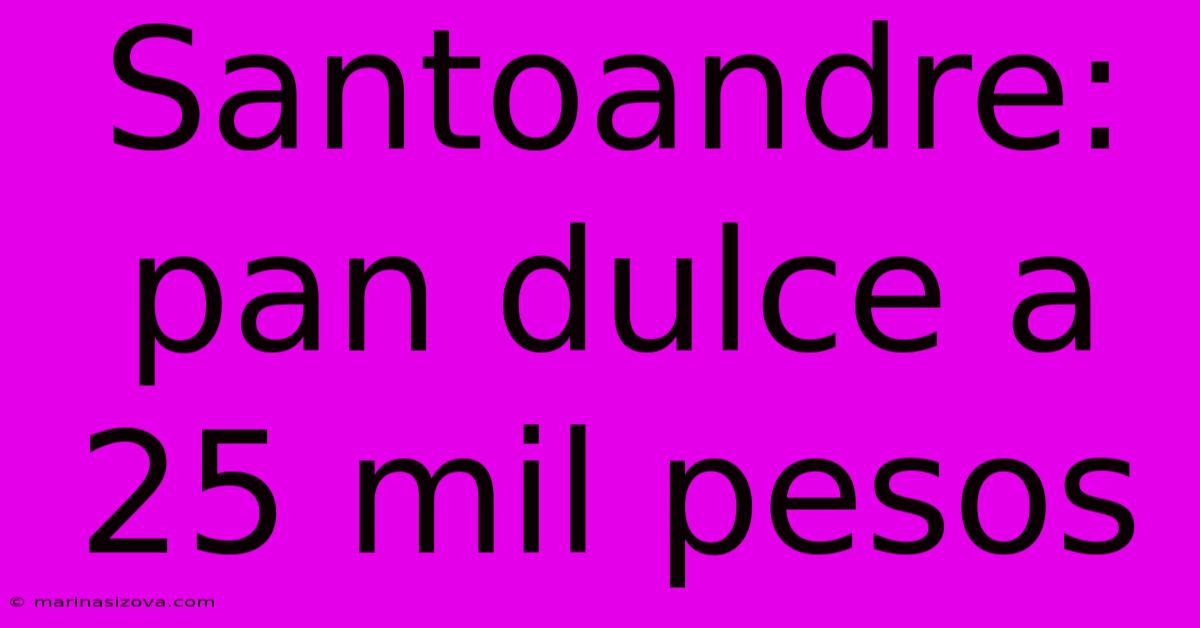Santoandre: Pan Dulce A 25 Mil Pesos

Discover more detailed and exciting information on our website. Click the link below to start your adventure: Visit Best Website. Don't miss out!
Table of Contents
Santoandre: Unveiling the 25,000 Peso Pan Dulce Phenomenon
Is a 25,000-peso pan dulce worth the price? Santoandre's exorbitant pan dulce is sparking debate, challenging perceptions of value and luxury in baking.
Editor's Note: This analysis of Santoandre's high-priced pan dulce was published today. Understanding the pricing and the factors behind this confection's cost is crucial for consumers and businesses alike. This exploration will delve into the reasons behind this unique product, analyzing its ingredients, marketing, and the overall market dynamics.
Why is this important? This case study provides valuable insights into luxury goods pricing, brand positioning, and consumer behavior in the context of a highly unusual product. It highlights the power of marketing and brand perception in influencing consumer spending decisions, even on everyday items like bread.
Analysis: This article meticulously examines Santoandre's 25,000-peso pan dulce, dissecting the factors contributing to its extraordinary price tag. We researched publicly available information, including press releases, social media commentary, and economic data relevant to luxury goods in the region, to compile a comprehensive guide.
| Claves del Análisis | Descripción |
|---|---|
| Ingredientes Premium | High-quality, often imported, ingredients. |
| Elaboración Artesanal | Traditional, meticulous baking process, possibly involving specialized techniques. |
| Exclusividad y Marca | Strong brand identity, positioning the product as a luxury item. |
| Experiencia de Lujo | Packaging, presentation, and possibly associated services enhance the perceived value. |
Santoandre: A Deep Dive into the 25,000 Peso Pan Dulce
Introduction: Santoandre's 25,000-peso pan dulce represents a fascinating intersection of traditional baking and luxury branding. Understanding its pricing necessitates a deep analysis of several key aspects.
Key Aspects:
- Premium Ingredients: The use of exceptionally high-quality ingredients is a primary driver of cost.
- Artisan Production: Meticulous, handmade production processes significantly impact pricing.
- Luxury Branding: The brand's image and marketing contribute substantially to its perceived value.
- Unique Selling Proposition (USP): The pan dulce’s unique characteristics justify the high price.
Premium Ingredients
Introduction: The selection of ingredients is critical in understanding the high cost of the pan dulce.
Facets:
- Role of Ingredients: The ingredients directly influence the final product's quality and flavor profile.
- Examples: Consider the use of specific types of flour, exotic spices, or imported fruits.
- Impacts and Implications: Premium ingredients dictate a higher production cost.
Summary: The choice of premium ingredients is fundamental to Santoandre's pan dulce and directly contributes to its elevated price. This is a core component of its luxury positioning.
Artisan Production
Introduction: The labor-intensive, handcrafted nature of the baking process is a significant cost factor.
Further Analysis: The time and skill involved in artisan production significantly influence the overall cost. Consider the specialized techniques employed, the baker's expertise, and the time investment.
Closing: The artisan element creates a unique product, justifying a higher price point compared to mass-produced alternatives.
Luxury Branding
Introduction: Santoandre's brand positioning as a luxury item plays a crucial role in its pricing strategy.
Facets:
- Role of Branding: Branding shapes consumer perception, influencing willingness to pay a premium.
- Examples: Exclusive packaging, limited availability, targeted marketing campaigns.
- Risks and Mitigations: Maintaining a consistent brand image and managing consumer expectations are vital.
Summary: Santoandre's strategic branding successfully positions its pan dulce as a high-value product, justifying its price.
FAQ
Introduction: Addressing common questions regarding Santoandre's 25,000-peso pan dulce.
Questions:
- Q: What makes this pan dulce so expensive? A: A combination of premium ingredients, artisan production, and luxury branding contributes to the high price.
- Q: Is it worth the price? A: The value proposition is subjective, depending on individual preferences and perceptions of luxury.
- Q: Who is the target customer? A: The target customer is likely affluent individuals seeking a unique and luxurious experience.
Summary: The high price reflects a multifaceted strategy combining quality ingredients and luxury branding.
Tips for Understanding High-End Goods
Introduction: Guidance for navigating the market for luxury items.
Tips:
- Research ingredients and production methods.
- Consider the brand's reputation and marketing strategies.
- Assess the value proposition in relation to your individual needs and budget.
Summary: Informed decision-making is crucial when considering luxury goods.
Conclusion: A Reassessment of Value
Summary: Santoandre's 25,000-peso pan dulce challenges conventional notions of value. Its high price reflects a deliberate strategy combining exceptional ingredients, artisan craftsmanship, and shrewd luxury branding.
Closing Message: This case study highlights the power of branding and strategic positioning in the luxury market. It prompts a broader conversation about how consumers perceive and value products at different price points. While the cost may seem extravagant to some, it reveals a distinct market segment willing to pay a premium for a unique and luxurious experience.

Thank you for visiting our website wich cover about Santoandre: Pan Dulce A 25 Mil Pesos. We hope the information provided has been useful to you. Feel free to contact us if you have any questions or need further assistance. See you next time and dont miss to bookmark.
Featured Posts
-
Harbaugh Clash Nfl Family Feud
Nov 26, 2024
-
Retour Kimpembe Munich Etape Decisive
Nov 26, 2024
-
Ronaldo Juega Al Gharafa Vs Al Nassr
Nov 26, 2024
-
Psg Kimpembe A Munich Retour Possible
Nov 26, 2024
-
Idzes Main Penuh Venezia Nyaris Menang
Nov 26, 2024
